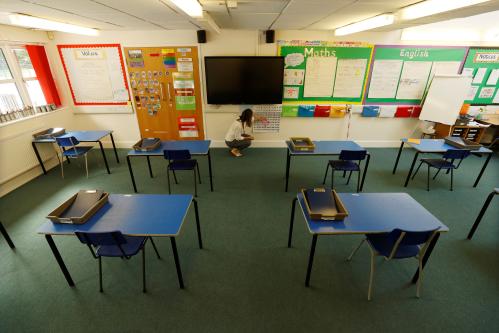This article is the fourth installment of a series entitled, “Federal aid for schools and COVID-19.”
As school districts around the country begin to announce a wide range of plans for the fall, COVID-19 infection rates are on the rise and the economy remains in recession. Senate Republicans and the White House are considering conditioning at least part of additional federal aid on opening schools for in-person instruction. Schools can and should only open for in-person instruction when the local public health situation permits, so Congress should avoid bogging down stabilization aid with ill-advised strings.
The basic fact is that schools need money that they can spend flexibly to meet local needs, they need it soon, and states cannot borrow to cover lost revenue. The federal government must step in with a substantial aid package and, as we’ve argued in a previous Chalkboard post, Congress should not complicate the distribution of aid by attaching strings or reduce flexibility by specifying how funds should be spent. Whether schools are open for in-person instruction, for distance learning, or use a hybrid approach, they will need federal funding to prevent recession-lengthening layoffs and to support student learning. We described how Congress can equitably allocate aid to states while promoting flexibility and avoiding confusion that comes with using existing programs like Title I—the federal program for compensatory education—to allocate aid.
In addition to choosing how much aid to provide and how to divide it among the states, Congress will need to direct states how to distribute aid to local school districts. In recent (the CARES Act) and proposed legislation (the HEROES Act in the House and the Coronavirus Child Care and Education Relief Act in the Senate), Congress has chosen to direct states to distribute aid to districts proportional to existing Title I allocations. In this post, we argue that Congress should not—and need not—require states to use Title I to distribute aid to school districts. In this piece, we outline alternative approaches.
What’s been done and what’s been proposed
The relief bills, like other federal education legislation, breaks the allocation of federal aid into two distinct steps: first to the state level, and then to districts within states. In the CARES Act, Congress used the same approach for both steps: The bulk of funds were allocated proportional to existing Title I allocations at each stage. But Congress doesn’t have to use the same exact formula or even the same basic approach for both allocations. They can mix and match, as they did with stabilization aid during the Great Recession.
Table 1 below summarizes the allocation methods for both stages (federal-to-state and state-to-district) used in major education stabilization packages and proposals of the recent past. In our previous post in this series, and in this working paper (forthcoming in the National Tax Journal), we show the implications of different formulas for how federal funds are allocated to states.
In short, allocating proportional to Title I (as was done for the majority of school funding in the CARES Act) sends more funds per child to states with higher poverty rates, but it also incorporates arbitrary variation in per-child funding across states. The approach taken in the Governor’s Emergency Education Relief (GEER) Fund of the CARES Act or the HEROES Act (passed by the House) distributes aid progressively—poor states get more—but avoids problems associated with using Title I. Senate Democrats’ proposed Coronavirus Child Care and Education Relief Act would add additional funding to both GEER and the Elementary and Secondary School Emergency Relief (ESSER) Fund within the CARES Act, so the method of allocation would be the same as in CARES.
Table 1: Federal relief programs for elementary and secondary education, passed and proposed
| Method of distributing federal funds to states | Method of distributing funds to school districts within states | |
| 2009 American Reinvestment and Recovery Act’s (ARRA) State Fiscal Stabilization Fund |
61% population age 5-24 39% total population |
States use their own general aid school finance formulas to allocate federal dollars to districts. |
|
2020 CARES Act Governor’s Fund (GEER) |
60% population age 5-24 40% poor population age 5-17 |
State education agency decides based on impact of covid-19 on educational services |
|
2020 CARES Act Elementary and Secondary School Emergency Relief (ESSER) Fund |
Proportional to state share of national Title I dollars. | At least 90% of funds distributed proportional to Title I |
| HEROES Act (House-passed) |
61% population age 5-24 39% poor population age 5-17 |
At least 90% of funds distributed proportional to Title I |
| Coronavirus Child Care and Education Relief Act (Senate) | Structured as CARES Act GEER and ESSER Funds | Structured as CARES Act GEER and ESSER Funds |
In this post, we focus on the implications of the formulas used to divide states’ allocations to local school districts. Congress has taken three approaches to within-state allocations so far. The distribution of CARES GEER funding was at the discretion of governors, which makes sense for a relatively small emergency fund. During the Great Recession, Congress directed states to run the stabilization funds through their main state aid formulas, whereas states were required to distribute CARES ESSER funds to districts proportional to Title I allocations (retaining up to 10% for state use).
Why not use Title I to direct funds to districts?
Using existing Title I allocations was an attractive option for distributing aid under the CARES Act for two reasons: Title I helps poor places more, and the use of existing allocations made it easy to divide up the relief funds quickly. These reasons may also explain why congressional Democrats chose to retain this allocation method from the CARES Act in subsequent proposals in the House and the Senate. But using Title I allocations as the basis for distributing stabilization funds comes with some significant—but not obvious—drawbacks.
The biggest issue is that Title I funds come with a host of restrictions intended to ensure they are used for compensatory purposes. Currently, schools need stabilization aid to fill in flexibly for lost state revenue; while relief funds are not Title I, associating them with the program through the allocation method can lead to serious confusion among school administrators about what is and is not allowed. The dust-up over “equitable services” funds for private schools is just one visible example of this. The fundamental problem is that districts view Title I as supporting “extra” or “supplementary” services, but the shocks to revenue that most districts are experiencing mean schools need funds not only to support the additional costs of social distancing and remote instruction, but also to support the basics—like teacher salaries.
Spending rules aside, the formulas behind the Title I allocations present similar problems for districts as they do for states. While Title I is based on poverty and delivers more funds per pupil to poorer school districts on average, the allocations vary considerably among districts with similar poverty rates. The non-linearities and hold-harmless clauses of the program’s four formulas generate visible winners and losers. For example, consider these three cases from Michigan: Detroit Public Schools, with 80% of students eligible for free lunch, received $1,684 per pupil under CARES ESSER; Rutherford Winans Academy, a charter school in Detroit with 83% of students eligible, received $640 per pupil; and rural Bangor Public Schools, with a free-lunch rate of 80%, received $278 per pupil. Though it’s possible that state leaders in Michigan may prefer to vary the amount of per-poor-pupil aid that schools in different locales receive, there is no reason to believe the Title I allocations are going to get it right.
Finally, while Congress may especially wish to support spending in poorer districts, the federal government’s ability to control the distribution of spending across districts within states is inherently limited. That’s because states may adjust how they direct their own revenue to districts depending on how much federal aid districts receive, as recently demonstrated by how the state of New York responded to the CARES Act. This is a longstanding concern related to federal funding. While it may seem possible to regulate away such behavior through maintenance-of-effort (MOE) requirements, it is hard to achieve. Effective MOE rules require knowledge of just how much effort could be maintained, and how much effort would be maintained absent federal funds. This is challenging in the best of times, when the unknown counterfactual is how much school spending would have increased, absent federal aid. Now, with both school revenues and expenditures for safe operation so uncertain, it is hard to come up with an MOE requirement that would be significant enough to be meaningful, without being unattainable.
Luckily, Congress has feasible alternatives to Title I for dividing up federal stabilization aids within states.
Alternative 1: Congress creates a weighted formula based on poverty
All districts face budget shortfalls due to the pandemic and recession, but higher-poverty districts are facing greater challenges, so it makes sense that Congress wants to direct more federal funding to poorer school districts. Instead of Title I, however, Congress could take a similar approach to what was done to allocate funds to states in GEER of the CARES Act, and is proposed in the Governor’s Fund of the Coronavirus Child Care and Education Relief Act as well, distributing some aid proportional to the number of poor school-aged children and the rest proportional to the count of all school-aged children. These data are readily available, and calculating state allocations using them for the CARES Act—which distributed 40% of the aid proportional to the number of poor children age 5-17 and 60% proportional to the population count ages 5-24—was straightforward. Those weights are not set in stone. For example, states could be directed to distribute half of aid proportional to a districts’ share of poor children in the state and half on a per-pupil basis; increasing the share based on poor children would make the allocation more progressive.
This type of weighted formula would solve most of the problems associated with using Title I discussed above. However, states could still take actions to undo the targeting implied by the weighted formula by adjusting how much state aid they provide to poorer districts relative to less-poor districts. This is an inherent limitation of any stabilization formula, and a reason not to let political fighting over the weights undermine quick passage of an aid package. The federal government has far more control over distribution of stabilization funds to states, so directing more aid to poorer states is more likely to result in meaningful redistribution to poorer children than directing more money to poorer districts within states.
Alternative 2: Congress directs states to use their school finance formulas
Alternatively, Congress could follow the approach used in the American Recovery and Reinvestment Act (ARRA) and direct states to distribute aid through their general formulas. Legislative language for this approach could be taken from ARRA, and states have some experience administering such a program and understand it as flexible general aid. This makes intuitive sense since a major function of the aid is to replace lost state aid due to the recession.
Most states direct more aid to poorer districts, so simply replacing lost state aid will tend to help poorer districts more. In most states, this approach would direct less federal funding to poor districts than allocations proportional to Title I, but the ultimate effect on spending would depend on how states respond. The weighted approach above could be more or less progressive than state finance formulas depending on the weights in the federal allocation formula and the nature of each state’s school finance formulas. This approach has the benefit of being a relatively straightforward way to replace state revenue lost to the COVID recession, with existing legislative language from ARRA available as a guide.
Congress needs to act soon
Our foremost caution in this series is worth repeating here: Congress should avoid using Title I to allocate federal relief aid, either to states or to districts.
The most important thing that Congress can do now is to act quickly and provide enough money so that all schools can provide instruction in whatever form is most appropriate for their local circumstances. Whether adopting social distancing protocols for live instruction or developing remote-learning offerings, all schools will face new costs this school year that, without federal support, will undermine their ability to provide a quality education. Even without these new costs, schools would need federal aid to make up for lost revenue from states. The well-being of families and children, the economic recovery, and the nation’s future depend on Congress sending substantial aid to schools soon.
The authors did not receive financial support from any firm or person for this article or from any firm or person with a financial or political interest in this article. The authors are not currently officers, directors, or board members of any organization with a financial or political interest in this article.
The Brookings Institution is committed to quality, independence, and impact.
We are supported by a diverse array of funders. In line with our values and policies, each Brookings publication represents the sole views of its author(s).










Commentary
Schools need flexible federal aid now. What should Congress do next?
July 27, 2020